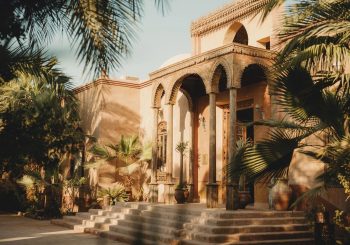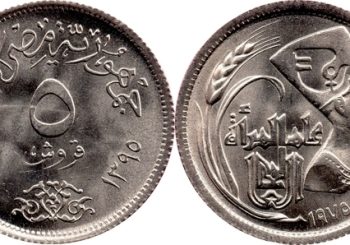Egypt is currently in the midst of constructing the New Administrative Capital, a visionary urban development project poised to herald a transformative chapter in the nation’s history. Envisioned as an economic powerhouse and a symbol of contemporary progress, this new city represents a national project that boasts a monumental investment of EGP 40 billion (USD 1.29 billion).
However, before Egypt embarked on this ambitious endeavor, and even predating the founding of its iconic capital, Cairo, the country has had its fair share of historic capital cities throughout its rich history.
From ancient Egypt through Hellenic and Roman rule to the Arab conquest and the shaping of modern Egypt, the country’s history is intertwined with the ascent and decline of numerous empires. Each has left its own mark on Egypt’s history and culture, including through the construction of capital cities. Here is some of the history behind the country’s older capitals and the monuments that define them.
Memphis

Located 24 kilometers away from modern Cairo, Egyptologists believe that Memphis was founded around 2925 BCE by King Menes, the Pharaoh who united Upper and Lower Egypt. The name Memphis comes from the Greek version of Men-nefer, which means White Walls, referring to a palace made of whitewashed bricks.
Memphis was Egypt’s capital during the Early Dynastic and Old Kingdom periods and a center for the god Ptah’s worship. Even the word Egypt originates from the temple’s ancient name, Hikuptah, meaning “The Temple of the soul of Ptah.”
Owing to Memphis’ monumental importance, it was selected as a UNESCO World Heritage Site in 1979.
The ancient city’s historical importance is evident in nearby cemeteries like Abu Rawash, Giza Plateau, Zawyet Al Aryan, Abu Ghurab, Abusir, Saqqara, Mit Rahina, and Dahshur. These locations house a variety of funerary rock tombs, mastabas, temples, and pyramids, including the world-renowned Pyramids of Giza.
Thebes

The ancient city of Thebes, currently modern Luxor in the south of Egypt, was one of the most important cities from the Middle Kingdom onwards. The vast majority of the ancient Egyptian monuments that can still be visited there today were built during the New Kingdom.
Ancient Thebes and its necropolis, or burial areas, were named a UNESCO’s World Heritage Site in 1979. The monuments of the ancient capital include the Karnak temple complex and Luxor Temple on the east bank of the Nile, and those on the west bank include the temple of Ramesses III in Medinet Habu; the Ramesseum of Ramesses II; Amenhotep III’s Colossi of Memnon; the temple of Hatshepsut in Deir al-Bahari; the tombs in the Valley of the Kings, where Tutankhamun was buried; the tombs in the Valley of the Queens; and the town and tombs of the workmen of the royal tombs in Deir al-Medina.
Sphinx Avenue is one of the most significant archaeological parts of the ancient city of Thebes. The avenue is around 2,700 meters long, connecting Karnak Temples in the north with Luxor Temple in the south.
The Avenue was built by ancient Egyptian kings between the Eighteenth Dynasty and Thirtieth Dynasty as a processional way for sacred ceremonies and festivals. Along the Avenue, unparalleled Sphinxes line up along the ancient road from Karnak Temples to Luxor Temple.
Tell Al Amarna

Tell Al Amarna is the archaeological site of the ancient Egyptian city of Akhetaton, located in Upper Egypt about 71 kilometers north of present-day Assyut. Constructed around 1348 BCE by Akhenaten, formerly named Amenhotep IV, it served as his capital after he abandoned the worship of Amon in favor of the Aton deity. However, approximately four years after Akhenaten’s death, around 1332 BCE, the royal court returned to Thebes, leading to the abandonment of the city.
Despite its short-lived existence, Akhetaton is one of the few ancient Egyptian cities that has been extensively excavated. The city’s unique location and relatively brief occupation allowed archaeologists to reconstruct its layout with remarkable precision.
Alexandria

Alexandria is a prominent city and governorate in Egypt. It was once a leading city in the Mediterranean world, renowned for its cultural significance and scientific advancements. Founded by Alexander the Great in 332 BCE, Alexandria served as Egypt’s capital until its conquest by Arab forces led by Amr Ibn Al As in 642 CE. Today, Alexandria stands as one of Egypt’s largest cities, serving as a major seaport and industrial hub. It is situated on the Mediterranean Sea at the western edge of the Nile River delta, approximately 183 kilometers northwest of Cairo in Lower Egypt, covering an area of 300 square kilometers.
Within just a century of its founding, Alexandria burgeoned into one of the Mediterranean’s most important cities and a hub of Greek scholarship and scientific inquiry. Great thinkers such as Euclid, Archimedes, Plotinus the philosopher, and geographers Ptolemy and Eratosthenes pursued their studies at the Mouseion, a prestigious research institution founded at the outset of the 3rd century BCE by the Ptolemies. This renowned institution also encompassed the celebrated library of the city, housing a vast collection of texts, with the majority of them composed in Greek.
The city is home to a number of unique attractions, including the ruins of an ancient Hellenic city submerged under the sea, a Roman amphitheater, and once, it used to boast one of the Seven Wonders of the Ancient World, the Lighthouse of Alexandria.
Alexandria’s unique geographical position, with its back to Egypt and its front to the Mediterranean, has given it a cultural complexity. Throughout its history, Alexandria has maintained a cosmopolitan character, often identifying more with the broader Mediterranean world than its immediate hinterland.
Al Fustat

Following the Arab conquest of Egypt in 642, Caliph Omar Ibn Al Khattab sought a new capital for Egypt, forgoing Alexandria, which had served as the capital during the Ptolemaic and Roman periods. Ibn Al As founded Al Fustat, marking it as Egypt’s inaugural Islamic capital.
The city’s name, Al Fustat, originates from the Arabic word for “tent,” inspired by the camp set up by Ibn Al As’ army at the future site of the new capital. The first structure in Al Fustat was the Mosque of Amr Ibn Al As, also known as Al Ateeq, meaning “the Old Mosque.”
Today, Al Fustat is a part of the Old Cairo District and stands as one of the city’s oldest areas. It boasts numerous archaeological sites, including the Synagogue of Ben Ezra, over seven historic churches, the Nilometer on Al Roda island, the palace of Al Manesterley, and the Mohammad Ali Palace in Al Manyal.
Al Askar

Al Askar was the capital of Egypt from 750 to 868, during the period when Egypt was a province of the Abbasid Caliphate.
Following the Rashidun Caliphate, the reach of the Umayyads became extensive, stretching from western Spain all the way to eastern China. However, as time went on and the caliphate dwindled, they were overthrown by the Abbasids, who moved the capital of the empire itself to Baghdad.
In Egypt, this shift in power involved moving control from the Umayyad city of Al Fustat to the Abbasid city of Al Askar slightly north. Its full name was Madinat Al Askari, meaning the City of Sections. It was primarily designed to accommodate an army, laid out in a grid pattern that could be easily subdivided into separate sections for various groups, such as merchants and officers.
Al Qata’i

Al Qata’i was the short-lived capital of Egypt during the Tulunid period, founded by Ahmad ibn Tulun in the year 868. It was situated immediately to the northeast of the former capital, Al Askar, making it adjacent to the old capital of Al Fustat. Eventually, all three of these settlements were merged into the city of Cairo, established by the Fatimids in 969 CE. Unfortunately, Al Qata’i met its demise in the early 10th century and today, the only remaining structure from that time is the Mosque of Ibn Tulun.
Cairo

Cairo’s name in Arabic is Al Qahira, which translates to the conqueress in English. It was established by the Fatimids under the leadership of General Jawhar Al Siqilli, following the orders of the Fatimid Caliph Al Mo’ez Ledin Allah, to serve as the new capital for the Fatimid Dynasty. Initially, it was named Cairo, but it is known by several other names over the years, including the City of a Thousand Minarets and Qahirat Al Mo’ez.
In the 11th century, Egypt came under the rule of Salah Al Din, who transformed Cairo into a metropolis of great renown and constructed the formidable Cairo Citadel. In the early 19th century, Muhammed Ali embarked on a mission to build modern Egypt. He built the Mohamed Ali Mosque, which stands as one of Cairo’s most captivating landmarks. His dynasty, the Alawites, continued the effort, transforming Cairo into the modern metropolitan that it is today.






Comment (1)
[…] post Between Past and Present: Exploring the Histories of Egypt’s Most Iconic Capital Cities first appeared on Egyptian […]